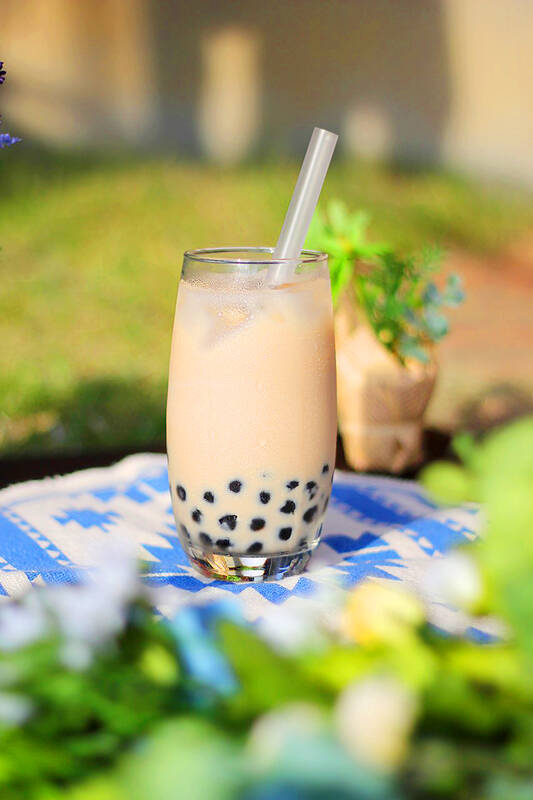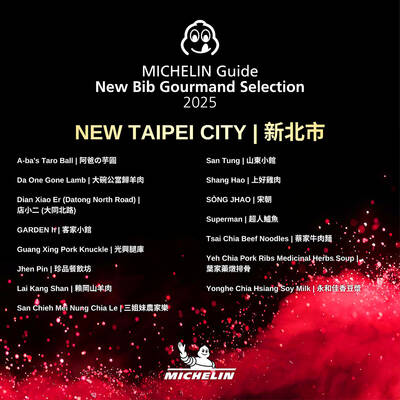Pearl milk tea is a national drink that has taken the world by storm. Although different stories are told about the origin of pearl milk tea, two of them stand out. The first comes from a tea house in Taichung named Chun Shui Tang. A staff member there named Lin Hsiu-hui was at a local market when she noticed tapioca balls (also known as “pearls”) for sale and thought to add them to her milk tea. She liked the taste, as did her colleagues with whom she shared her new drink. It started as a drink that was only shared with friends, but was so popular that it became a product – pearl milk tea.
珍珠奶茶是紅透全世界的國民飲品,其由來起源可說是眾說紛紜,最為人知的是兩間茶館之爭。台中的茶館春水堂,宣稱是店員林秀慧在菜市場採買時看到粉圓,靈機一動將粉圓煮熟後加在奶茶中,廣受同事間的好評。起初只是與好友分享的私房茶飲,後來因大受歡迎而成為商品。
national drink (n. phr.) 國民飲品

Photo: Pixabay l 圖片:Pixabay
tea house (n. phr.) 茶館
tapioca balls (n. phr.) 粉圓
The second origin story comes from another tea house in Tainan. The Hanlin Tea Room there claims that pearl milk tea was created by its owner Tu Tsong-ho, who saw a vendor selling white tapioca balls at the Yamuliao market. He came up with the idea of combining the tapioca balls with tea, leading to the first cup of bubble tea. The Hanlin Tea Room uses black and white tapioca balls (“pearls”) as its signature touch.
台南翰林茶館則說是由老闆涂宗和所創,涂老闆在逛鴨母寮市場時,看到有攤販販售白色粉圓,晶瑩剔透,想到到可以結合在茶飲中,於是第一杯珍珠奶茶就此誕生,翰林茶館也以黑、白雙色的珍珠為招牌。
vendor (n.) 攤販
Although the “pearls” in today’s pearl milk tea differ from those tapioca balls in the origin stories of the two tea houses, both are made from tapioca starch. The original tapioca balls are usually translucent on the outside and white inside, and often added as a topping to shaved ice. The tapioca balls used today are larger and black, like smooth round black pearls, giving bubble tea its well-deserved name.
雖然現今的珍珠奶茶的「珍珠」與粉圓外觀已有不同,但都是以木薯澱粉做成的。粉圓煮熟後有些透明,裡面為白色,時常加在剉冰中當作配料。相較於粉圓,現在珍珠奶茶中的「珍珠」更大更黑,有如一顆顆圓潤的黑珍珠,因此稱為珍珠奶茶,可說是名副其實。
Milk tea’s appeal today is already astonishing, and the addictive texture of the pearls makes the drinks irresistible to Taiwanese and foreigners alike. It is hard to imagine that this popular drink originated from tea houses that often have an impression of quiet and calm. Its popularity has led to the flourishing of Taiwan’s beverage industry, with an annual consumption of 1 billion cups. Nowadays pearl milk tea has become popular in Asia and has now expanded to other markets in Australia, Europe and the United States, with many brands competing for the market.
奶茶本身就已魅力驚人,再加上珍珠粉圓令人上癮的口感,不只台灣人喜愛,外國人也無法抵擋它的魅力。珍珠奶茶是如此受到歡迎,令人難以想像它原本是從靜謐的茶館中誕生。珍珠奶茶的風行使得台灣飲品業蓬勃發展,甚至達到年銷10 億杯的驚人數字。現在,這種飲料不但風靡亞洲,也進軍澳洲和歐美競爭飲料市場。
addictive (adj.) 上癮的
flourishing (adj.) 興旺的; 繁榮的
文章由書林出版公司提供:
www.bookman.com.tw

When Nvidia CEO Jensen Huang revealed on Friday last week that the company is working with the Trump administration on a new computer chip designed for sale to China, it marked the latest chapter in a long-running debate over how the US should compete with China’s technological ambitions. The reasoning has sometimes changed — with US officials citing national security, human rights or purely economic competition — but the tool has been the same: export controls, or the threat of them. Nvidia believes it can eventually reap US$50 billion from artificial intelligence (AI) chip sales in China. But it so far has

In 2024, multiple airplane accidents caused severe casualties, including a Jeju Air disaster at the year’s end. However, not all incidents ended in tragedy. Early in the year, a Japan Airlines flight caught fire after landing in Tokyo, but all 379 passengers and crew members escaped within 90 seconds. This event highlights the “golden 90 seconds” that experts emphasize — most survivors evacuate the plane within this critical window. Proper preparation ensures you can act quickly and decisively during these crucial moments when every second counts. Your survival strategy begins before takeoff. Wear long pants, a comfortable top, and

A: The Michelin Guide Taiwan announced the 2025 Bib Gourmand eateries and starred restaurants last week. B: What were the highlights this year? A: In addition to Taipei, Taichung, Tainan and Kaohsiung, New Taipei City and Hsinchu City and County were included for the first time. B: As a New Taipei resident, I can’t wait to try all the awarded local delicacies. Should we start from the more affordable Bib Gourmand selection? A: Sure, New Taipei and Hsinchu each boast 15 Bib Gourmand eateries now, including some famous establishments such as San Tung restaurant. A: 2025《米其林指南》近日公布「必比登推介」和星級餐廳。 B: 今年的名單有哪些亮點? A: 除了台北、台中、台南、高雄,今年加入新北、新竹縣市! B: 身為新北人,我真想吃遍當地的美食,我們要不要從平價的必比登先開始? A: 好啊新北、新竹各有15家入選必比登,像山東小館等知名餐廳都有上榜唷。 (By Eddy Chang, Taipei Times/台北時報張迪)

Week 23 : 詞法——名詞 1. 請給我兩張紙。 ˇ Please hand me two sheets of paper. χ Please hand me two papers. 註︰paper 作物質名詞(material noun)「紙」解時,沒有複數形式,要表達數量時前面要加量詞,作「學術報告」、「報紙」、「考卷」或「論文」等解時,可有複數形式。常見的物質名詞還有麵包(bread)、粉筆(chalk)等。 2. 祖母的頭髮已變灰白了。 ˇ Grandmother’s hair has already turned gray. χ Grandmother’s hairs have already turned gray. 註︰hair 統指頭髮(或毛)時只用單數。hairs 指多根頭髮(或毛),例如:She has several gray hairs.。另外,英文裡提到白頭髮習慣上多以 gray 一詞來代替 white,較為委婉含蓄。 3. 他沒有多少工作要做。 ˇ He doesn’t have a lot of work to do. χ He doesn’t have a lot of works to do. 註︰work 若指「工作」是不可數名詞,不能加 s,且不用不定冠詞。work 的複數形式表示下列幾種意義:(1) 著作,如 Chaucer’s works;(2) 工廠,如 China Steel Works;(3) 機器的轉動部分,如 the works of a watch;(4) 工程,如 public works。 4. 這是個好消息。 ˇ This is very good news. ˇ This is great news. χ This is such a good news. 註︰news 是不可數名詞,雖具有複數形式,但只用作單數,前面不可加 a,後面的動詞也應用第三人稱單數,如:Bad news travels quickly.